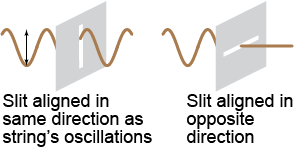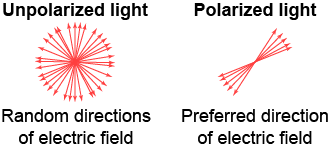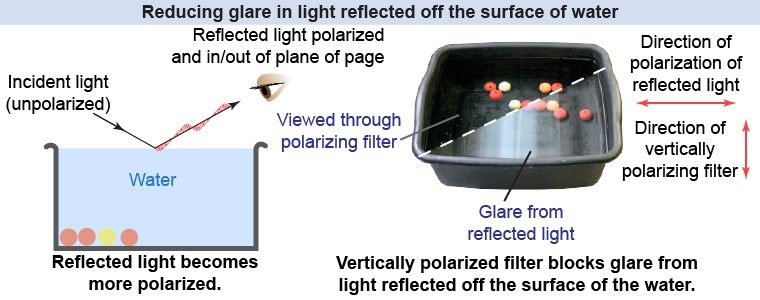|
Earlier in this chapter, light was described as an electromagnetic wave that propagates through oscillating electric and magnetic fields. In this section, you will learn that light can also be described as a photon, a tiny and indivisible packet of energy resembling a particle. So which is it, a wave or a particle? This perplexing conundrum lies at the heart of the microscopic world of the atom and quantum physics itself. 
|
Polarization
|
 Try oscillating a string vertically through a slit cut into a piece of cardboard. If the slit is cut in the same direction as the string’s oscillations, then the oscillations can pass through the cardboard. If the slit is perpendicular, then the oscillations are stopped altogether. This oscillating string serves as an analogy for the polarization of light, where the oscillations of light can be passed or blocked by a polarizing filter.
Try oscillating a string vertically through a slit cut into a piece of cardboard. If the slit is cut in the same direction as the string’s oscillations, then the oscillations can pass through the cardboard. If the slit is perpendicular, then the oscillations are stopped altogether. This oscillating string serves as an analogy for the polarization of light, where the oscillations of light can be passed or blocked by a polarizing filter. 
|
 Light is made of oscillations in the electric and magnetic field. If those oscillations are randomly oriented, the light is unpolarized. If the oscillations occur more in one direction than another, the light is polarized. Polarization is a property of the oscillation of a transverse wave in a direction perpendicular to the direction of propagation.
Light is made of oscillations in the electric and magnetic field. If those oscillations are randomly oriented, the light is unpolarized. If the oscillations occur more in one direction than another, the light is polarized. Polarization is a property of the oscillation of a transverse wave in a direction perpendicular to the direction of propagation. 
|
It can be difficult to see into a lake or swimming pool because of the glare of overhead light reflected off the surface of the water. Light that reflects off of nonmetallic surfaces, such as water or snow, becomes polarized in a direction parallel to the surface, i.e., in a horizontal direction. By viewing this reflected light through a vertically polarized filter—perpendicular to the direction of the horizontally polarized reflected light—the glare is reduced and you can see underwater more easily. Many sunglasses are sold with vertically polarized filters to reduce glare from reflected light. Polarized filters for cameras can increase contrast of the clouds in the sky. Look at the sky through a polarized filter or sunglasses. Does it sharpen the clouds? 
|

|
| |
|

